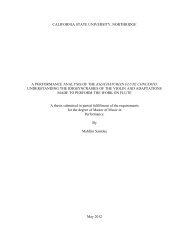2644 - CSUN ScholarWorks - California State University, Northridge
2644 - CSUN ScholarWorks - California State University, Northridge
2644 - CSUN ScholarWorks - California State University, Northridge
Create successful ePaper yourself
Turn your PDF publications into a flip-book with our unique Google optimized e-Paper software.
Journal of Student Research Abstracts · 83<br />
planarians took to travel a distance of 10 em. The five planarians from the experimental group were exposed<br />
to an EMF around 2.58*10A-3T(Tesla) when they traveled the 10-cm distance. No EMF was applied to the<br />
other five planarians from the control group. After 30 trials, there was no significant difference between the<br />
speed of planarians from both groups. (P>0.1) I further tested my hypothesis on my second experiment by<br />
increasing my sample size. Instead of using the same five planarians throughout all the trials like my first lab,<br />
I used planarians that had never been tested before for every trial to obtain more accurate data. However, the<br />
results were the same. The variation was not significant (p >0.1). Therefore, I concluded that EMF did not disrupt<br />
the direction of the flow of sodium ions by applying a force on them as they traveled through a neuron<br />
and therefore did not cause the planarians to travel slower.<br />
2831<br />
THE ENVIRONMENTAL FACTORS AFFECTING JONES CREEK.<br />
Justin Rhodes, Anita Haydar, M.C. Barlow (teacher). Smithfield High School, 14171 Turner Drive,<br />
Smithfield, VA 23430.<br />
The purpose of our research was to determine the quality and health of Jones Creek and to establish a database<br />
for the comparison of data collected by future students. The data was collected at the Nike Park site<br />
through various methods, which include water tests for: dissolved oxygen, salinity, pH, temperature, phosphates,<br />
nitrates, carbon dioxide, turbidity, and silica. Air temperature, air pressure, and other weather factors<br />
were also recorded. The various land and water uses and plants and wildlife were noted as well. We were also<br />
able to determine the various water and land uses and their effect on the water. From our data and observations<br />
the creek appears to be in good health. The dissolved oxygen and pH are at healthy levels and there are nutrients<br />
in the water but not enough to allow for any eutrophication. A great deal of wildlife and plant life was<br />
observed and seemed to be in good health. We were successful in our collection of data and future students<br />
will be able to monitor changes in the river based on our results.<br />
2832<br />
THE EFFECTS OF WAVELENGTHS OF LIGHT ON EUGLENA GRACILIS.<br />
Stephen Mar and Steve DeGusta (teacher). John F. Kennedy High School, 6715 Gloria Drive, Sacramento,<br />
CA 95831.<br />
In order to find if the rate of photosynthesis is related to wavelengths of light, cultured Euglena gracilis was<br />
separated into three different solutions; one without food coloring (White), one containing three drops Red<br />
food coloring per 50ml cultured euglena (Red), and one containing two drops Green food coloring and one<br />
drop Yellow food coloring per 50ml cultured euglena. (Green). Over the course of eight days, the euglena population<br />
of each solution was counted. On the eighth day, the Red solution showed a significant decrease in population<br />
compared with the euglena solution without food coloring (O.Ol>p>0.001). The Green solution showed<br />
a significant decrease in population compared with the euglena solution without food coloring (p













